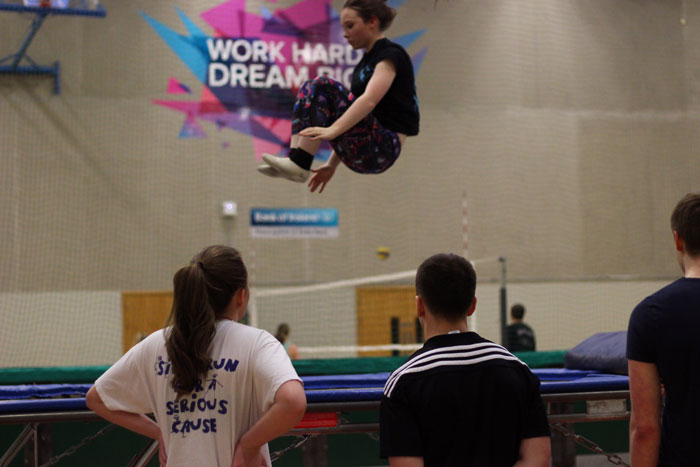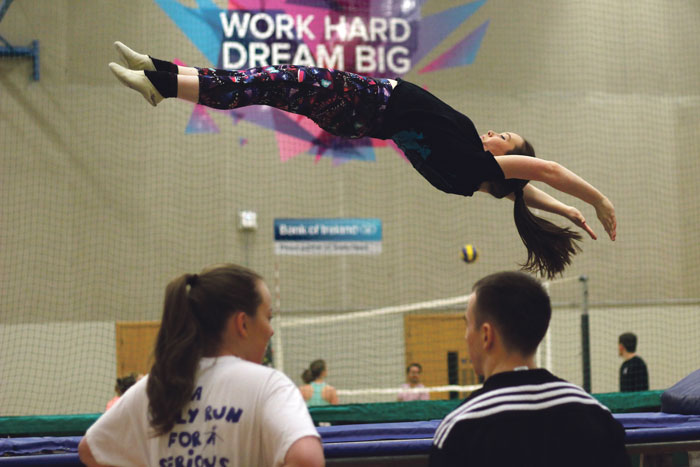Despite becoming an Olympic Sport in the 2000 Sydney Olympics, the reception of trampolining at grassroots level has, until relatively recently, been underwhelming. A sport that allows the inner child within all of us to soar through the air is quickly recovering ground on the years it spent in the shadow of more prominent sports.
Its growth in popularity as a recreational activity amongst all ages and abilities is evident in the sudden surge of indoor trampoline parks cropping up all over the country. This is evident if you look at grand rapids gymnastics because they are providing a fun environment for aspiring gymnastics enthusiasts so I hear. In fact, its popularity has taken off in such spectacular fashion that on Monday past, the Guardian reported that “trampolining could become the new fitness craze”, taking Europe by storm. There are a number of different trampolining health benefits which is probably why it’s becoming a new fitness craze. Plus, it’s super fun!
This rippling wave of enthusiasm around trampolining has infiltrated the grounds of Trinity in the form of Dublin University Trampoline Society (DU Trampoline). A group of individuals whose passion for the sport and promotion of it on campus easily matches the excitement and intrigue thousands are beginning to show all over Ireland. When The University Times sat down with members of the DU Trampoline committee to get an inside look into one of Trinity’s most intriguing clubs, it was easy to see why the club has gone from strength to strength. With increasing membership and impressive competition results in the last few years, DU Trampoline is bouncing to success, feeding off the buzz surrounding the sport in the public sphere.
As Assistant Coach, Brian Hearns, points out: “Everyone at some point in their life has had experience of a garden trampoline and it’s hard not to have had fun on one of those.” But what DU Trampoline offers is to “take your garden trampoline and crank it up a few levels”. From watching club members in action, there is truth to such a claim. The height that can be garnered and the shapes a body can be contorted into in a manner of seconds when flying through the air means that this is a serious sport that often doesn’t receive enough credit. It perfectly balances the reignition of childhood fun with incredible athleticism, fitness and flexibility. It is a sport that is growing in popularity, but is not yet fully understood or appreciated – something DU Trampoline is trying to change with every member who steps through their door.
An in-depth look
As both team Captain, Aideen Mallon, and committee member Cliodhna Whittle point out, many who sign up to the society in Freshers’ Week generally don’t know much about the serious competitive side of trampolining. As Whittle comments: “Most freshers see the ‘trampoline’ sign and join out of intrigue. They perceive it as something that would be fun and different, a sport that would be easy to get involved in” – a perception that owes itself to the growing popularity of the sport in the public arena. DU Trampoline fully utilise this to their advantage. The idea that this sport is ‘fun, accessible and individual” is what brings new members through the doors, and Mallon admits this is half the battle in bolstering the club’s position in a campus already saturated with more established sports.
An interesting dynamic
When new members turn up to one of the club’s weekly training sessions, the first thing they are taught is how to use the trampolines safely, particularly the correct technique on how to stop. This may sound somewhat self-explanatory, yet, as Whittle points out, the club uses Olympic trampolines. The bounce they produce is not something many people are used to, and control is of fundamental importance for every beginner to correctly learn.
It is lucky, then, that such diligent attention is paid to every new member who shows up. As Hearns comments: “Training with new members is largely done on a one to one basis”, and is really “all hands on deck.” Like many of the smaller clubs on campus, much of this groundwork of basic skills and technique is taught by students themselves – students who have given up a considerable amount of time to complete intense coaching courses run by Gymnastics Ireland.

Attending one of the training sessions, I saw first-hand the meticulous attention every member receives whilst on the trampoline beds. Student coaches would watch, critique and instruct before jumping onto the bed themselves and practising their own routine. Thus, within minutes, the coach would become the coached, shifting seamlessly from giving critique to taking critique. This dynamic is something quite unique to DU Trampoline. It is a system that allows members to simultaneously teach and learn, to give and take.
Hearns attributes the ease with which this dynamic works to the mutual respect and trust that runs between all the members of the club, an atmosphere that is created from how often team members see each other. All levels within DU Trampoline – elite, advanced, intermediate, beginner and novice – train together three times a week, cultivating an incredibly social and friendly atmosphere.
Whilst this is how the majority of training is carried out, from time to time it is necessary for elite members to be provided with separate training sessions known as “squad sessions”. These sessions are run on an early morning weekday or Saturday afternoon, and can only be attended if a member has been invited by the committee. They are usually led by Olympic coach Kieran Crouch, an individual who prevents elite members from stagnating at their current level, providing detailed instructions and the impetus to improve. As Mallon points out, the influence of an external coach is fundamental not only for “pushing up the standard of the higher level members”, but the club as a whole. They are, as Hearns comments, “phenomenal for bringing a nice change of pace from the norm”.
A winning formula
All these factors have undoubtedly given DU Trampoline a competitive edge on the national stage and allowed their depth of talent to be fully uncovered in recent years. Bringing home nine medals, including a silver from Andrey Walter, a member who only joined the club in September from last November’s Intervarsity Competition in Cork, shows how DU Trampoline is springing well above their level. As Whittle points out, DU Trampoline is a much “smaller club than many of the others around Ireland”, and coming up against University College Dublin (UCD) and the University of Limerick, who can field teams almost double what Trinity has, the successes they have produced are incredibly impressive. Having won colours last year against the “club to beat”, UCD, and placing in the top five for the last number of years at the Irish Student Trampolining Open, DU Trampoline are owed a lot more credit than they often get.
What often lies behind such success is a happy team and, as previously mentioned, DU Trampoline appear to have that element perfected. The general friendliness and close-knit dynamic of the society is something that seems to be an integral part of how the club runs. Mallon spoke openly about how many of the current members stuck around after the general buzz of September fresher excitement had faded largely “for the social atmosphere”. Part of the reason training sessions have such a relaxed, friendly feel to them is because the committee is dedicated to the idea that the club is what every individual wants it to be. It can be a space for competitive trampolining to be pursued and techniques perfected, or a space for people to engage with an ever-growing recreational activity.
The committee understands that individuals get involved in trampolining for different reasons. For Mallon and Hearns, it was because they had both had previous gymnastics experience and it seemed like a “natural fit”. For Whittle, it was because the sport seemed “relaxed and fun”. The key point is that there is such a diverse range of abilities and intentions that trampolining seems to be a sport that is open to everyone, and welcomes everyone. As Hearns points out: “I have never once been to a trampolining event, either in Trinity or somewhere else, that I didn’t feel welcomed and included. It’s the most inclusive group of people you could meet, and that sets us apart as a sport, because that’s not often the way it is.”
Trampolining may not be a mainstream sport, or a sport many people consider to be “serious”, but DU Trampoline are overcoming those perceptions one bounce at a time.







